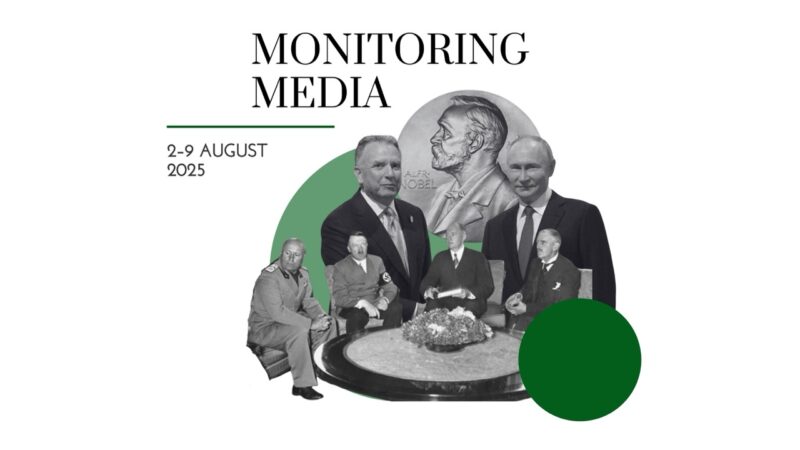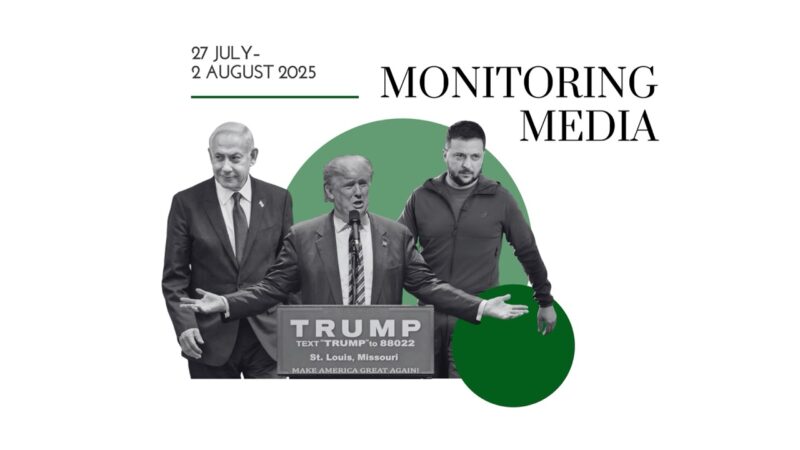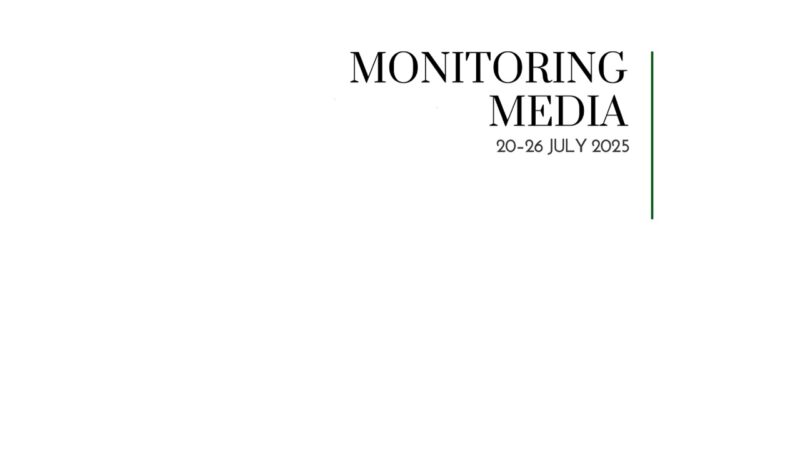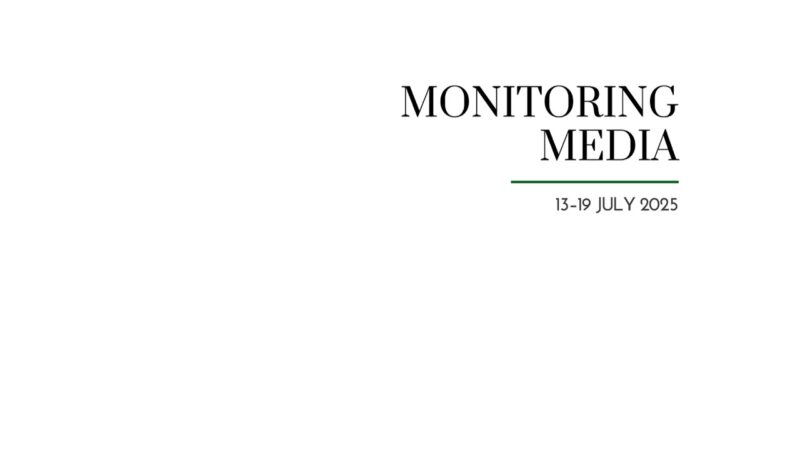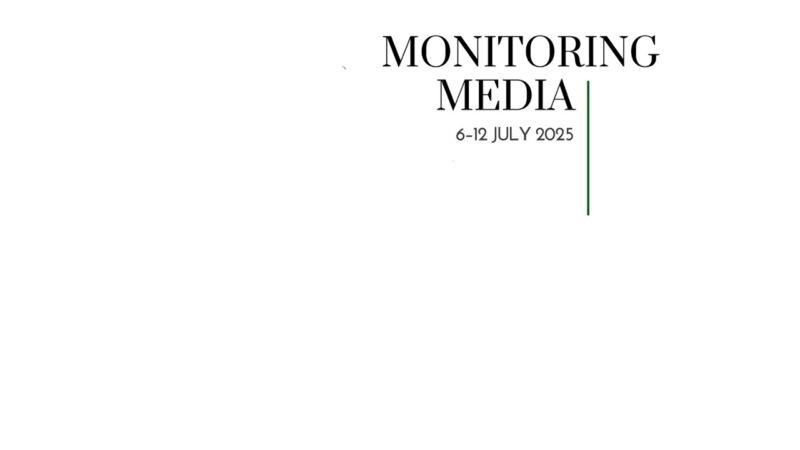Russia ramps up sabotage across Europe

CIUS weekly report on North American media coverage of Ukrainian affairs, 12–18 May 2024
Six publications (Foreign Policy, The Wall Street Journal, The Economist, Winnipeg Free Press, The Hub, and Toronto Star) were selected to prepare this report on how Ukraine has been portrayed in the North American press during the past week. The sample was compiled based on their impact on public opinion as well as on their professional reputation, popularity among the readership, and topical relevance. These publications represent centrist viewpoints on the political spectrum.
This MMS report covers only the most-read and relevant articles about Ukraine, as ranked by the respective North American publications themselves in the past week. Its scope covers promoted articles on home pages and articles from special sections on Ukraine, with the hashtag #Ukraine, from the paper editions of the publications, and about Ukraine from opinion columns and editorials.
Featured topics
- The world and Ukraine: the “nuclear mind game” is changing; the White House must choose a strategy for Ukraine.
- Russia at war: Russia is ramping up sabotage across Europe; steep increase in Russian air strikes on Ukraine; re-elected Putin ascends to deity status in Russia.
MMS summaries
Russia is ramping up sabotage across Europe. Editorial analysis by The Economist focuses on Moscow’s shadow war against NATO. This war is a kind of second front that Russia has unleashed in its war against Ukraine and the West. In April 2024 alone, European states detained many pro-Russian saboteurs: “Germany arrested two German-Russian dual nationals on suspicion of plotting attacks on American military facilities and other targets on behalf of the GRU, Russia’s military intelligence agency. Poland arrested a man who was preparing to pass the GRU information on Rzeszow airport, the most important hub for military aid to Ukraine. Britain charged several men over an earlier arson attack in March on a Ukrainian-owned logistics firm in London whose Spanish depot was also targeted.” Similarly, the fire that broke out at the Diehl Metall plant in the suburbs of Berlin on 3 May could have been the result of sabotage. Diehl’s parent company produces “the iris-t air-defence system which Ukraine is using to parry Russian missiles.” The editors believe that this secret war of Russia against Europe is nothing new: “In 2011 the GRU blew up an ammunition depot in Lovnidol in Bulgaria. It followed that up with two explosions at the Vrbetice arms depot in the Czech Republic in October and December 2014, where ammunition bound for Ukraine was being held. All these incidents were tied to members of Unit 29155, the GRU’s sabotage-and-assassination squad.” Russia has also become bolder on the cyber front: “A report published by Google’s Mandiant cybersecurity division in April noted that ‘hacktivist’ groups with loose ties to the GRU had made credible boasts of manipulating the control systems for water utilities in America and Poland, and what the hackers thought was a hydroelectric facility in France. The GRU had previously conducted sophisticated cyber-attacks on Ukraine’s critical infrastructure both before and after the full-scale invasion of 2022.” Moscow believes that time is in its favour and is therefore taking every possible hybrid warfare measure, aiming to weaken and divide Ukraine’s allies.
Russia increases its air strikes on Ukraine. Alistair MacDonald, Jemal R. Brinson, Emma Brown, and Ievgeniia Sivorka (Wall Street Journal) emphasize that today Ukraine is shooting down a far smaller proportion of Russian missile attacks compared to earlier in the war; meanwhile, Russia is increasing the number of attacks and using more harder-to-hit weapons. The key reason for these successes is the limited ammunition for Ukraine’s Patriot systems supplied by the West: “In the past six months, Ukraine intercepted around 46% of Russian missiles, compared with 73% in the preceding six-month period, according to…daily data from the Ukrainian Air Force Command. Last month, the interception rate fell to 30% of missiles. The interception rate for long-range Shahed drones, which are easier to shoot down, fell by 1 percentage point to 82% in the past six months.” Russian bombardment is destroying civilian infrastructure and cities in Ukraine, depleting its already small stockpile of missiles. According to the authors, the next two months will be crucial in determining whether the Russian air force can be deterred effectively before new deliveries of Western air defence equipment arrive in Ukraine. The Kremlin understands this too, which is why “over the past six months, Russia fired around 45% more drones and missiles than in the preceding six-month period.” In the previous six months, Russia “fired 114 ballistic and 46 hypersonic Kinzhal and Zircon missiles, compared with 33 and 27, respectively, for the previous six months. Moscow has also repurposed air-defense systems to attack Ukraine, firing 175 missiles from its S-300 or S-400 air-defense system into unoccupied Ukraine this year alone.” According to the authors, “The Patriot is Ukraine’s only reliable way to shoot down ballistic, S-300, and hypersonic missiles. But Kyiv has few Patriot systems and has had to conserve missiles, not least as fresh US supplies were held up in Washington.”
The nuclear mind game is changing. Rose Gottemoeller (Foreign Policy) notes that Russia’s nuclear threats to achieve conventional goals in Ukraine mark a new era of brinkmanship. This is confirmed, for example, by an order of Russian President Vladimir Putin on May 6 to conduct exercises with the use of nuclear weapons: “The exercises will simulate ‘theater,’ or regional, nuclear attacks, in contrast to ‘strategic’ nuclear exercises simulating war with the United States. These theater exercises will be centered in Russia’s southern military district, likely targeting not only Ukraine but also NATO members Romania, Bulgaria, and Turkey.” According to the author, neither Washington nor Moscow wants a conflict between NATO and Russia in Europe. It is therefore natural to ask why Moscow continues threatening with the nuclear stick. Part of Moscow’s rhetoric is due to “the Kremlin’s effort to derive value from this very brinkmanship—a pattern of behavior rarely seen since the 1962 Cuban missile crisis, the last time the world came to the brink of a nuclear exchange.” In other periods of the Cold War, there was a certain stability between the two superpowers, which “became so boring and reliable that people more or less forgot about nuclear annihilation.” However, Russia’s war against Ukraine has shattered this complacency, and now the world’s states must once again consider the threat of nuclear war. In its rhetoric, Moscow links NATO’s support for Ukraine to a strategic defeat of Russia—for obvious reasons: “If its people believe that the country is facing total destruction, they will stay in the fight for the sake of survival.” There is an important lesson here for the US and its allies: “The fabric of nuclear deterrence is changing, its mind game adjusting to a new era of nuclear brinkmanship.” Therefore, the US and its allies must follow clear rules to maintain a stable and strong deterrent. The first rule should be discipline in the use of terms such as “strategic defeat,” so as not to acquiesce to claims that Washington and its allies are the ones posing an existential threat. The second rule should be to maintain the effectiveness of the US’s nuclear deterrent and the reliability of its command and control systems. Third, at the negotiating table the US must confidently pursue the mutual predictability that comes from nuclear arms control and limitation. Fourth, Washington and its allies need to maintain steady reliability and quiet confidence in providing military assistance to Ukraine: “The most serious implication of the delayed funding vote in the US Congress was that the United States could be halted in its tracks by a bully brandishing nuclear weapons.” According to Gottemoeller, “Working together with allies, the United States can drive nuclear statecraft forward in ways that preserve nuclear predictability and, at the same time, strengthen deterrence. The fabric of nuclear deterrence may be changing, but determining its future must not be left to the aggressors.”
White House must hold to a consistent Ukraine strategy. Raphael S. Cohen and Gian Gentile (Foreign Policy) is convinced that the excruciating approval process of the latest aid package for Ukraine by the US Congress exposed a strategic paradox that hinders the White House’s strategy to support Ukraine. On the one hand, President Biden promises that “our commitment to Ukraine will not weaken” and that US support will be there “for as long as it takes.” On the other hand, the Biden administration “has been steadfastly concerned about escalation and the prospect of a direct confrontation with a nuclear-armed Russia.” In the author’s opinion, both positions are correct, but they work for opposite purposes. Such a “balanced approach” on the part of Washington will sooner or later lead to an aggravation of the problem. Initially, White House’s strategy was based on the belief that time was in Kyiv’s favour. But two years later, we see the opposite trend: “Starved of weapons and ammunition, Ukraine has been forced to cede ground on the battlefront—with Russia making its most significant advances since July 2022 and supposedly gearing up for a summer offensive.” Thus, Kyiv needs to change its war strategy. First, Ukraine must strike deep into Russian territory. Secondly, Ukraine should build up its air power if it is to succeed in its ground counteroffensive Third, in order for Kyiv to acquire the air power it needs, it will require a broader suite of capabilities, including higher-flying, sophisticated drones and electronic warfare capabilities from either ground or air-based platforms. Fourth, Ukraine will have to assume greater operational risks when it launches its counteroffensive. Ukraine’s Western allies should also change their thinking on supporting Ukraine. According to Cohen, “For the Biden administration […] accepting such risk will mean abandoning a pillar of its strategy for the past two years, choosing a single path, and accepting the potentially escalatory consequences that might follow. That’s a tough choice. Not choosing, however, may be even riskier.”
Inconsistent Western aid leaves Ukraine vulnerable to Russian military advances. James Horncastle (Winnipeg Free Press) notes that Russia’s recent offensive against Ukrainian forces in Kharkiv oblast unexpectedly achieved significant gains because of Ukraine’s inadequate defenses, as a result of inconsistent and delayed military support from Western allies. Although initially Western aid, including anti-tank missiles and training, helped Ukraine to resist the Russian aggression, subsequently it was reactive and insufficient. For instance, in the fall of 2022 Ukraine managed a successful counteroffensive despite only partial aid, but the lack of sustained support prevented Ukrainian forces from entrenching their gains, leading (in part) to the current vulnerabilities. “The western material aid allowed Ukraine to launch counteroffensives but it wasn’t enough to sustain and subsequently entrench these offensives,” Horncastle adds. The inconsistency of Western support has played into the Kremlin’s hands, allowing it to exploit Ukraine’s weaknesses and influence Western political dynamics. Delayed provision of crucial equipment, exacerbated by tactics like Russian disinformation affecting US domestic politics, has created a critical shortfall in Ukraine’s defenses. US Secretary of State Antony Blinken’s recent visit to Kyiv demonstrated that Ukraine urgently needs a long-term support strategy to avoid repeating past mistakes and to properly plan for future operations. “Ukraine lost an opportunity to exploit Russian vulnerability in 2022 due to its allies’ unwillingness to provide necessary material aid,” the author concludes. “Russia is preparing for a long war, and so should those who want Ukraine to succeed. Crucial to that reality is establishing a long-term, and consistent, material aid program.”
Following sham re-election, Putin ascends to deity status in Russia. Ian Garner (The Hub) argues that Vladimir Putin’s recent inauguration for his fifth term as president marks a dangerous inflection point for Russia, its leader, and its public. Emulating the opulent coronation of Tsar Nicholas II over a century ago, Putin’s ceremony was steeped in elaborate ritual and religious symbolism, positioning him as a near-omnipotent ruler. Patriarch Kirill of the Russian Orthodox Church blessed Putin with unparalleled reverence, suggesting he might reign until “the end of the century” and likening him to historical military heroes like Alexander Nevsky and Peter the Great. This new portrayal of Putin as a godlike figure signals a profound shift in his public image, where “the distinctions between the sacred and the secular have all but evaporated.” The deification of Putin accompanies his framing of the ongoing war in Ukraine as a pivotal moment in Russia’s history. By presenting the war (which in Russia has persistently been labelled as a “special military operation,” side-stepping a formal declaration of war) as a necessary struggle that will lead to a grand future, Putin has garnered support among a segment of the Russian population that genuinely OR blindly views him as divinely ordained. The increasing use of religious and mythical rhetoric by the Kremlin and the Moscow Patriarchate has fostered a cult-like following, with ordinary Russians on social media sanctifying the leader as “sent by God.” Garner notes that “Putin has never so concertedly attempted to deify himself,” and this dangerous blend of state-led sanctification and public zealotry raises the spectre of mass hysteria and ideologically driven atrocities, echoing the tragic history of leaders who have justified their actions by divine right.
Ukrainians with disabilities overcome challenges to achieve success and change social awareness. Julia Marich (Toronto Star) reminds readers that Russia’s current war against Ukraine has left over 50,000 Ukrainians with at least one limb lost, adding up to a staggering three million people with disabilities in the country. Defying longstanding challenges in fostering inclusivity, a significant shift toward acceptance and integration has emerged—highlighted, the author adds, by heartwarming encounters of disabled individuals who navigate daily life with resilience and support. The Ukrainian narrative of inclusivity has evolved from Soviet-era reservations to a burgeoning societal ethos that embraces diversity and opportunity for all. While Ukraine grapples with the immense task of rebuilding amidst the war, the imperative to create an inclusive society becomes paramount, not only as a moral obligation but as a testament to the indomitable human spirit. Ukrainian businesses are also recognizing the potential of veterans and disabled individuals as valuable contributors to the workforce. Both local and nationwide initiatives aimed at rehabilitation and workplace adaptation reflect a growing recognition of these individuals as essential human capital, underscoring a shift toward a culture of inclusivity in both public perception and corporate ethos. Stories of facing daunting challenges—like that of military veteran Oleksandr Budko, a new hero of the Ukrainian version of “The Bachelor”—serve as a powerful reminder of resilience and hope, affirming that even in the face of adversity, ordinary people can find their paths of empowerment. “The world does not like the weak,” Marich concludes.
Worth your attention
Amid Putin’s nuclear threats, Canada needs to assess how far it will go in confronting Russia. Thomas Walkom (Toronto Star) emphasizes that the war in Ukraine is reaching a critical juncture as Ukrainian forces are pushed back and losing territories to a resurgent Russian military. NATO and its allies, including the US and Canada, face a stark choice: either accept defeat or escalate their involvement to unprecedented levels. To win, according to Walkom, NATO may need to consider the previously unthinkable—taking the war directly to Russia and potentially employing the nuclear threat. This situation reflects NATO’s longstanding policy of reserving the right to use nuclear weapons first, a strategy originally designed to compensate for its lack of conventional manpower against Russia’s massive armies. The alliance is now “always on the edge of nuclear war,” as its current predicament highlights the risks inherent in this kind of nuclear deterrence strategy. As NATO’s conventional military support falls short of securing a Ukrainian victory, the situation grows increasingly volatile. Ukraine has intensified its tactics by targeting Russian territory—a strategy previously avoided in order to prevent a supposed nuclear response from Moscow. Walkom believes that the US has allowed for plausible deniability regarding these attacks, claiming that Ukraine dictates its own war strategy. Along with France’s recent musings considering the deployment of forces to Ukraine, this raises the risk of a nuclear confrontation. The author concludes by asking, “Will the US and NATO accept the loss? Or will they try to turn it into a win—no matter the cost?”
MMS responds: Putin has repeatedly warned that Russia could retaliate with nuclear weapons if the West sends troops to Ukraine. In his annual State of the Nation address on 29 February, the Russian leader declared that any attempt to deploy Western forces in Ukraine threatens a conflict with nuclear weapons and the destruction of civilization.
This latest warning was the most explicit in the series of nuclear threats Putin has made since launching the full-scale invasion of Ukraine in February 2022. At the invasion’s outset, Putin cautioned against Western interference, promising unprecedented consequences.
After Russia’s defeat in the March 2022 Battle of Kyiv, Putin aimed to dissuade the West from arming Ukraine by hinting at a swift and potentially nuclear response.
Prior to this recent statement, Putin’s most infamous nuclear threats occurred during a televised address in September 2022, coinciding with Russia’s first mobilization since World War II. With the Russian army facing setbacks in Ukraine, Putin referenced the nation’s nuclear arsenal and pledged to utilize “all means at our disposal” for defense, emphasizing that this was not a bluff.
If Russia succeeds in normalizing nuclear intimidation as a foreign policy tactic, numerous countries may feel compelled to pursue their own nuclear arsenals. There are indications that this issue is already being discussed in certain circles. Speaking in February 2024, Polish Foreign Minister Radoslaw Sikorski cautioned that without additional US support for Ukraine, “some countries will start hedging, and others will consider developing their own nuclear weapons programs.”
By yielding to Putin’s nuclear threats, Western leaders risk ushering in a new era of insecurity and aggression worldwide. Russia’s effective use of nuclear coercion in Ukraine could reshape attitudes toward nuclear weapons and undermine decades of nonproliferation efforts. Nuclear arms may become seen as essential for countries that seek to resist coercion from their neighbors, heightening the risk of nuclear conflict and the potential for proliferation to non-state actors.
President Putin’s decision to employ nuclear intimidation as part of the Ukraine invasion is a dangerous gamble, rooted in his perception of Western vulnerability. Unless the West disproves this notion, the consequences for global security could be catastrophic.

